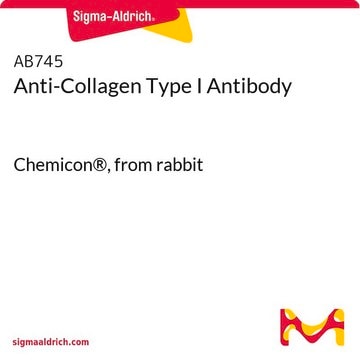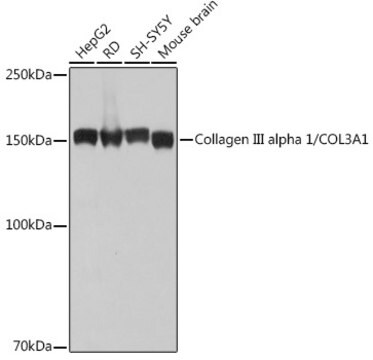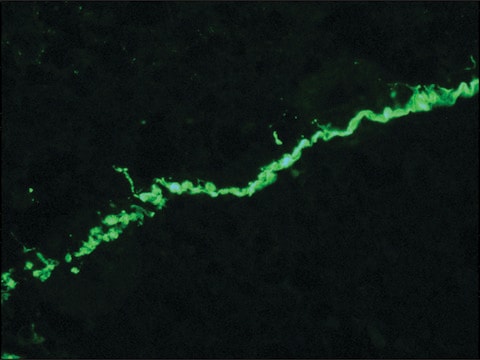AB747
Anti-Collagen Type III Antibody
Chemicon®, from rabbit
Sinónimos:
Anti-EDS4A, Anti-EDSVASC, Anti-PMGEDSV
About This Item
Productos recomendados
origen biológico
rabbit
Nivel de calidad
forma del anticuerpo
fractionated antiserum
tipo de anticuerpo
primary antibodies
clon
polyclonal
reactividad de especies
human
fabricante / nombre comercial
Chemicon®
técnicas
ELISA: suitable
immunofluorescence: suitable
idoneidad
not suitable for Western blot
not suitable for immunohistochemistry (Paraffin)
Nº de acceso NCBI
Nº de acceso UniProt
Condiciones de envío
wet ice
modificación del objetivo postraduccional
unmodified
Información sobre el gen
human ... COL3A1(1281)
Especificidad
Cross Reactivity Percent
Human collagen type I 10%
Human collagen type II 2%
Human collagen type III 100%
Human collagen type IV and V 4%
Human plasma proteins do not interfere with binding to collagen.
Inmunógeno
Aplicación
Indirect immunofluorescence on cryostat sections or cultured cells 1:20-1:40
Optimal working dilutions must be determined by the end user.
Forma física
Immunoglobulin fraction was prepared by ammonium sulfate precipitation and chromatography on DEAE-cellulose, of antiserum cross-absorbed over immobilized human serum proteins, immunoglobulins, and collagen types I, II, IV and V.
Almacenamiento y estabilidad
Información legal
Not finding the right product?
Try our Herramienta de selección de productos.
Opcional
Código de clase de almacenamiento
12 - Non Combustible Liquids
Clase de riesgo para el agua (WGK)
WGK 2
Punto de inflamabilidad (°F)
Not applicable
Punto de inflamabilidad (°C)
Not applicable
Certificados de análisis (COA)
Busque Certificados de análisis (COA) introduciendo el número de lote del producto. Los números de lote se encuentran en la etiqueta del producto después de las palabras «Lot» o «Batch»
¿Ya tiene este producto?
Encuentre la documentación para los productos que ha comprado recientemente en la Biblioteca de documentos.
Nuestro equipo de científicos tiene experiencia en todas las áreas de investigación: Ciencias de la vida, Ciencia de los materiales, Síntesis química, Cromatografía, Analítica y muchas otras.
Póngase en contacto con el Servicio técnico







